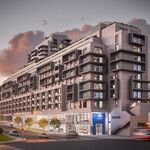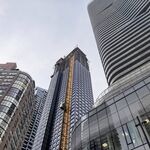Juan_Lennon416
Senior Member
1-Inform the population
2-Get councillors support and media coverage to help inform the population
3-Meet with the eventual candidates and "lobby" for subways
How soon do you plan on doing #1 and #2 on the list?
1-Inform the population
2-Get councillors support and media coverage to help inform the population
3-Meet with the eventual candidates and "lobby" for subways
How soon do you plan on doing #1 and #2 on the list?
Well, that's why I keep pimping out this.
What I'd love to see for Scarborough is recognition that Scarborough Centre (a mall! ew! ick!) is the main hub of the area and a radial transit approach makes the most sense. The Sheppard and BD subways should be finished to STC, while LRT lines should run up McCowan, to Malvern along the RT extension route, and along Ellesmere (which Durham Region is already considering).
^^ Which they'll have to be doing anyways once we realize that the SELRT shouldn't have been created in the first place. For vastly superior service, we could get a subway at only a tiny bit more than the LRT.
For political buy-in you should probably overlay the ward boundaries on any plan you come up with to know which councillors will loose or gain from the original Transit City plan. If a ward looses service inside its boundaries (LRT/BRT removed or Subway downgraded to LRT/BRT) then subtract 1 or if a ward gains service (new LRT/BRT/Subway or LRT/BRT made subway) add 1. If the plus minus count is neutral or higher and the price tag is near neutral then you would have the greatest likelihood of political support.
Who cares about a deficit? Just add to the cost of the deficit by building subways instead of an LRT. We can always get our kids to pay for it down the road, or tracks, with higher taxes.
Actually, this is an interesting concept.
Biggest problems would be not with the plan itself, but with implementation:
1) Being very different from the current TTC plans, it will be very hard to explain and sell.
2) Extra $$. You did a decent job of offsetting some costs with cuts in other places, but still it would cost more than the current plan.
Speaking about the plan per se - many interesting ideas. Even the blue BRT line, Malvern - STC - current SRT alignment - McCowan - Kingston, makes some sense - if it can be built inexpensively - as a connection within Scarborough.
Some objections:
1) Eglinton east of Don Mills gets express bus only - that does not seem right. That street has quite a bit of potential, and would be better off with at least LRT.
2) Sharp angle that connects Eglinton subway and DRL does not seem right, either. How many riders will travel across the tip? Most of the riders getting to that tip, will transfer to / from connecting routes: Don Mills, Eglinton, Lawrence.
There shouldn't be a permanent mode change on Eglinton at Don Mills. My preference is to run a continuous LRT on Eglinton. But if you manage to get subway west of Don Mills, it is better to keep it open-ended for future extension towards Kennedy, rather than loop into DRL.
DRL / Don Mills mode change makes more sense, although an alternative of future extention of the subway further north, or north-east, may be considered.
Future generations will be grateful that we spent 20 billion to do it right than 15 billion to do it so-so and leaving them with billions worth of work to do (to fill all of TC's gaps and flaws).




